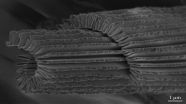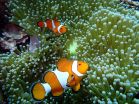The presence of roseola virus in chromosomes triples the risk of angina
2015-06-16
(Press-News.org) This news release is available in French.
Quebec City, June 16, 2015--People whose chromosomes contain the DNA of the roseola virus are three times more likely to suffer from angina, according to a new study by researchers from the Université Laval Faculty of Medicine, the CHU de Québec Research Center-Université Laval, and the University of Washington. Details of this finding are published in the latest issue of the Proceedings of the National Academy of Sciences.
Roseola, also known as "sixth disease," is a very common childhood infection caused by the HHV-6 virus. Symptoms include a fever and a rash that dissipates after a few days. Once the infection has cleared, however, the virus does not disappear but instead takes up residence in the cells. In a small percentage of cases, the virus's DNA gets integrated in the chromosomes, including eggs or sperm.
"When that happens, the genetic material of the virus can be transmitted just like human genes," says the study's lead author, Louis Flamand, professor at the Université Laval Faculty of Medicine and researcher at CHU de Québec. Children are born with a copy of the HHV-6 DNA in every cell of their body. We wanted to determine whether this situation, which affects 40 to 70 million people in the world, increases the risk of developing a range of diseases."
To find out, researchers analyzed biological samples and health information of nearly 20,000 people recruited through CARTaGENE, a project to sequence the genome of a cross-section of the province of Québec's population. The analysis showed that the HHV-6 DNA was integrated into the chromosomes of 0.6% of people tested. A cross-check with CARTaGENE medical data revealed that the prevalence of angina in this group of subjects is three times greater than in the general public.
Professor Flamand acknowledges that the nature of the link between angina and HHV-6 remains unclear. One hypothesis put forward by the researchers is that the virus affects the length of telomeres, the regions at the ends of chromosomes. By measuring telomere length in patients in their sample, researchers found that they were 24% shorter in people who were both angina sufferers and HHV-6 carriers than in non-HHV-6-carriers. "This telomere shortening may be associated with premature aging of cells lining the walls of blood vessels, and may initiate an inflammatory reaction that could lead to angina pectoris," Dr. Flamand suggests.
Detecting integrated HHV-6 in human chromosomes is easy, notes Dr. Flamand. "We could easily track this condition at birth, as we already do with hereditary diseases, and more closely monitor people whose chromosomes contain the virus."
INFORMATION:
In addition to lead author Louis Flamand, study authors are Dr. Annie Gravel, Isabelle Dubuc, and Dr. Guillaume Morissette of the infectious and immune diseases division of the CHU de Québec-Université de Laval Research Center, and Dr. Ruth Sedlak and Dr. Keith Jerome of the University of Washington. The study was made possible by a grant from the Canadian Institutes of Health Research.
Information:
Louis Flamand, PhD, MBA
Department of microbiology, infectious disease and immunology
Faculty of Medicine
Université Laval
418-525-4444 ext. 46164
Louis.Flamand@crchul.ulaval.ca
ELSE PRESS RELEASES FROM THIS DATE:
2015-06-16
The SAMT project of the European Union will work together with leading industrial actors from the cement, oil, metal, water, waste and chemical industries and review the latest scientific developments within the field of sustainability assessment. In the first phase of the project, a total of 90 methods and tools were reviewed. In the second phase, the best performing methods and practices will be tested with real-life case studies.
'The industries can learn from each other by sharing information on their methods and tools to evaluate sustainability. The SAMT project ...
2015-06-16
Protected forested areas in Brazil, Costa Rica, Indonesia and Thailand have prevented the release of more than 1,000 million additional tons of carbon dioxide into the atmosphere, an economic service provided by nature worth at least $5 billion, according to new research by Georgia State University economist Paul Ferraro with alumnus Merlin M. Hanauer and colleagues.
In an article published this week by the Proceedings of the National Academy of Sciences, the authors use this finding to show how conservation research methodology is improved by joining its two distinct ...
2015-06-16
A study conducted by the Zoological Society of London (ZSL) has revealed the importance of single males in small, threatened populations. Results from a study of endangered New Zealand hihi birds (Notiomystis cincta), published this week in Evolutionary Applications, showed that bachelor males who don't hold breeding territories, known as 'floaters', could help maintain genetic diversity and decrease the likelihood of inbreeding by sneakily fathering chicks.
These underestimated individuals are vital to the long-term survival of small populations, such as in the hihi, ...
2015-06-16
Researchers of the Max Delbrück Center for Molecular Medicine (MDC) in the Helmholtz Association, in collaboration with the National Heart Research Institute Singapore (NHRIS), have gained new insights into the regulation of disease-associated genes. They used a new technique that enables them to observe gene regulation at the level of protein production. They could thus capture more individual gene regulations than with traditional methods that only capture gene expression and transcription (Nature Communications, doi: 10.1038/ncomms8200)*.
When a gene is read, ...
2015-06-16
Researchers from North Carolina State University have created stretchable, transparent conductors that work because of the structures' "nano-accordion" design. The conductors could be used in a wide variety of applications, such as flexible electronics, stretchable displays or wearable sensors.
"There are no conductive, transparent and stretchable materials in nature, so we had to create one," says Abhijeet Bagal, a Ph.D. student in mechanical and aerospace engineering at NC State and lead author of a paper describing the work.
"Our technique uses geometry to stretch ...
2015-06-16
Researchers from the ARC Centre of Excellence for Coral Reef Studies at James Cook University have discovered that suspended sediment damages fish gills and can increase the rate of disease in fish.
"Suspended sediments result from flood plumes, coastal agricultural and industrial development and from dredging operations and are increasing in coastal waters worldwide," says study co-author, Dr Amelia Wenger.
"Fish gills are in direct contact with their environment and are the first line of defence in the animal's immune response, which makes them the perfect place ...
2015-06-16
University of Tokyo researchers have discovered the structure and transport properties of the "intermediate state" in lithium-ion batteries - key to understanding the mechanisms of charge and discharge in rechargeable batteries. These findings may help accelerate battery reaction speed and significantly shorten battery charging time.
Although there is strong demand to minimize battery-charging time, the mechanisms of battery charge and discharge reactions have yet to be fully understood. While the existence of an "intermediate state" that accelerates battery charge and ...
2015-06-16
Researchers have discovered that extreme exercise can cause intestinal bacteria to leak into the bloodstream, leading to blood poisoning.
Experts at Monash University monitored people participating in a range of extreme endurance events, including 24-hour ultra-marathons and multi-stage ultra-marathons, run on consecutive days.
"Blood samples taken before and after the events, compared with a control group, proved that exercise over a prolonged period of time causes the gut wall to change, allowing the naturally present bacteria, known as endotoxins, in the gut to ...
2015-06-16
A promising type of vaccine designed to eradicate malaria by blocking parasite transmission could be a step closer, as a result of experts uncovering new information about the targeted protein.
The international team of researchers co-led by Dr Natalie Borg from the Department of Biochemistry and Molecular Biology at Monash University, and Dr Rhoel Dinglasan from the Malaria Research Institute at the Johns Hopkins Bloomberg School of Public Health in Baltimore, USA, focused on a protein in the Anopheles mosquito midgut called AnAPN1.
The research, published in the journal ...
2015-06-16
Restricting teenagers from driving unsupervised at night, and introducing strict penalties and other licensing requirements, could reduce crashes significantly, according to research.
Published in Health Affairs, the study by researchers from Monash University and Harvard Medical School, shows that driving laws that eliminate or deter unsupervised night driving by people younger than 18 achieve substantial reductions in car crashes.
Car crashes are the leading cause of death among people aged 15-19 worldwide. In the US, where the study was based, teen drivers experience ...
LAST 30 PRESS RELEASES:
[Press-News.org] The presence of roseola virus in chromosomes triples the risk of angina


